How to Draw Hands Step by Step for Kids
A lot of people tell me that the thing they feel more complicated to draw is the hands!
I've always had a kind of love-hate relationship with hands.
Because I always loved to watch hands on cartoons or illustrations and how much emotion they can convey!
So I wanted to do that as well.
The problem was the part of figuring out the position and how to draw the hands.
UPDATE: If you're interested in watching this in video format, I've added a section to my Figure Drawing course teaching you how to draw Hands step by step! Grab it here with a discount: Introduction to Figure Drawing.
Here you'll learn how to draw hands step by step, using simple shapes.
We'll go over how to draw the fingers and thumb, as well as different kinds of hands and even going over all the details that you can add!
Getting Hand Reference Photos and Poses
I always like to start with references.
It's very important to get the right hand reference photos and poses for you to use.
This will help you draw better and more believable hands much faster!
Besides photo references that you can get (and that I will talk about right after), one amazing reference that you can get is an Articulated Hand Mannequin (click to check it out on Amazon).
I highly recommend this if you're struggling with drawing hands!

I've even talked about it in my Recommended Tools article about mannequins.
Having a mannequin that you can pose around and change the lighting on is priceless!
Every pose that you can imagine, you can pose it.
Other than that, let's talk about a few other photo references for drawing hands.
I love Pinterest.
As an artist, the amount of quality photos that you can get there to use as inspiration and reference is nearly infinite.
Thousands and thousands of photos are posted there each day. Sure, some may not have amazing quality, but most of the times you can find whatever you're looking for.
Also, even if they don't have super high "studio" quality, that can be a good thing.
Having a random photo that someone took with their phone can help you create a more realistic drawing.
To get photo references for hands on Pinterest you can try searching "hand photography" and see what comes up.
But if you want to save the trouble of searching throughout thousands of images, I've created a specific Pinterest board with the best hand references I could find!
So here's my Hand Reference Photos for Artists Pinterest board!
Magazines
Another way to find good photos to use as a reference is by looking through magazines.
This is especially good if you already have a few magazines that you bought and are just lying around. And well, if not, you can always just go buy a few magazines that you like and search through there!
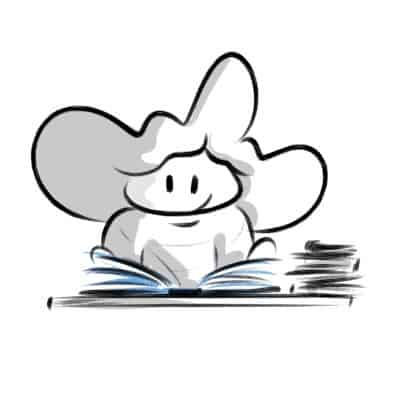
My best recommendation in terms of Magazines is to get Fashion Magazines orJewelryrelated magazines since those tend to have lots of hands.
Take Your Own Photos
Here's another great option for getting good hand pose references, take your own photos!
Doesn't really matter if you have a high-quality camera or not, grab your phone and take pictures of the poses you want.
This is something that I've done when looking around for hand references when writing this post.
Since I couldn't find the specific poses that I wanted I just took a photo of them! I've also included all those photos as a downloadable resource at the end of this article. So stick around for that and feel free to use them anywhere!
I talk all about Art References and Resources for Artists on a lengthy article with several examples and websites, so if you'd like to read more, check out my Article!
Drawing Hands Step By Step
Alright, time for practice!
First of all, we're starting with the basics of basics.
A simple open hand, so you can nail down the main shapes you'll use for almost any position!
There are two ways you can go about it, the first way is: take a photo, open it on your drawing software of choice or print it. Draw on top of it.
Tracing your photos is always a good way to learn the shapes. A lot of times, when learning to draw something new, this is how I go.
The second way is following the next steps! I've done part of the job for you.
So just follow the steps below and let's master drawing hands!
Start With The Palm
This is where I start. For the palm of the hand, we make almost a square shape, a bit rounded and going thinner on the bottom.
Pay attention to the arched line we draw here, it's very important!
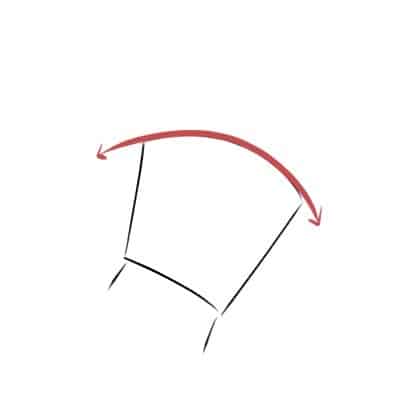
If you look at your hands, you'll notice that the line where your fingers touch the palm of the hand is usually curved.
This is important to figure out our next shape and its position.
The Finger Arc
Alright, so half our hand is done.
Now for where our fingers will be: above the shape, we repeat the same curved line that we did before.
So, in short, you'll always have the same curve!
Unless you really want to exaggerate your hands and try out different styles, of course.
With this new line, you just need to close the shape and there you go! We have a complete hand.
Now we just need to draw the shapes for each finger.

Drawing the Finger Joints
If you find it easier, especially in the beginning, this might be the best way to figure out each finger: Circles.
Draw a circle for each joint, including the thumb.
When you're finished, you just need to connect each circle, with a line around it:
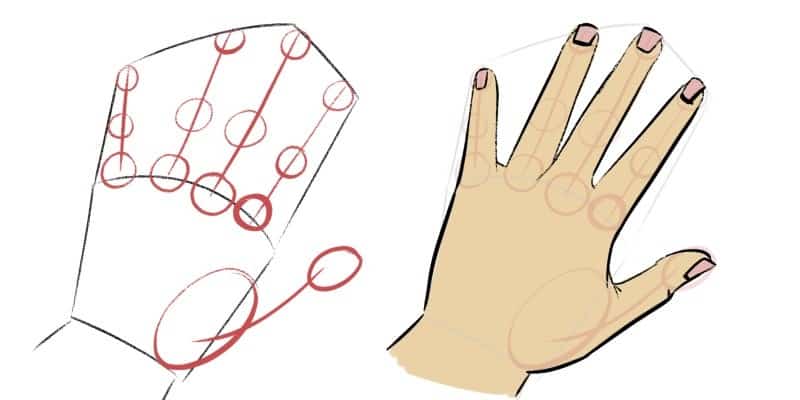
How to Draw Fingers (The Thumb Is Pretty Different)
The fingers have lots of details and different ways to draw them, depending on their position or how they're flexing.
And the thumb is a whole different shape and style!
So let's see how to draw them in more detail.
One of the best ways is to draw the finger flexing and extending.
There are many stages for the flexing of a finger, let's go for the 3 main ones:
Stretched Fingers
We already went through this one in the steps above, but let's go through it again very quickly.
Draw a horizontal line. Now let's add the joint circles. When all the shapes are done, we just need to connect them, with a single line.
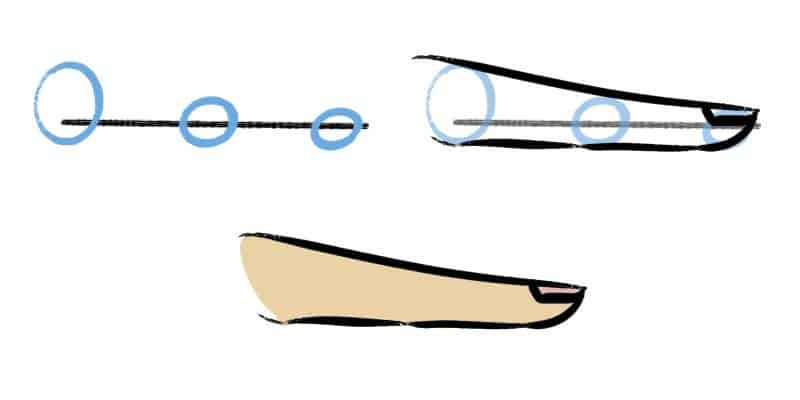
As you can see, we are viewing our finger from the side this time, so it looks a bit different. The top part of the finger is very straight, but the bottom is more rounded.
Half Flexed
Let's start again, with a line. Almost like a cane, but laying down.
Afterward, we do our circles: one at the start of our line, one in the first corner and the last in the second corner of our line.
Again, we just need to connect everything up!
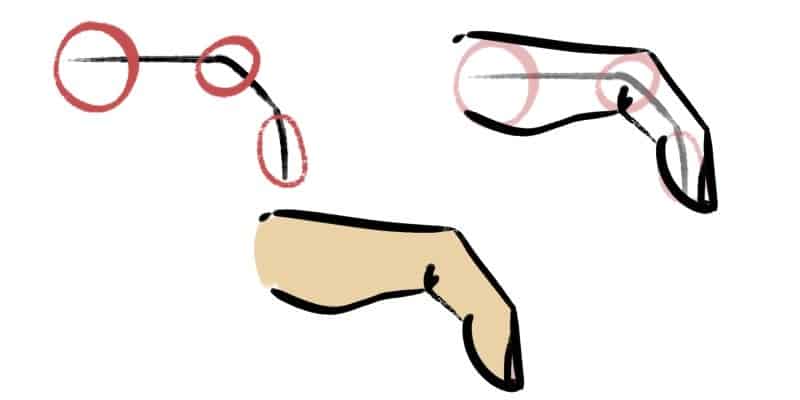
As you can see, the outside part of the finger has very straight lines, while the inside has lots of curves.
This is the way your fingers will always behave, so remember these shapes!
Flexed
Alright, last position. The finger here will be completely flexed. We can draw a square shape or a square spiral.
Now, as always, add the circles and join everything together.
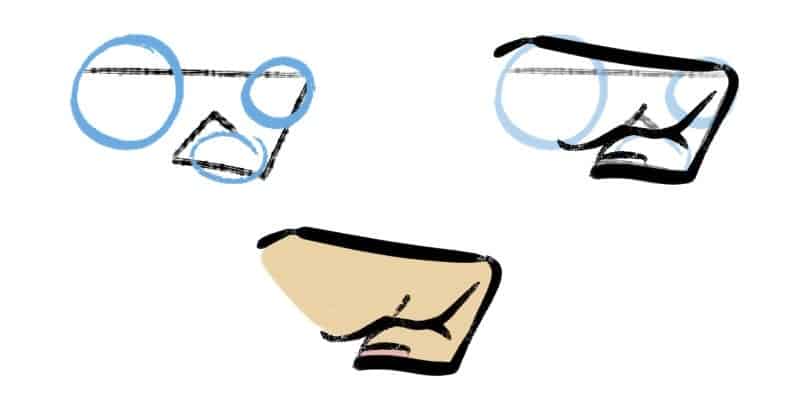
Thumb and the Circle in the Palm
The thumb is a bit different to draw.
As you noticed before, we start with a circle in the palm, from there, if it helps you, you can draw a curved line, going outside the hand.
If not, you can jump to the next part: Draw a rectangle and then a circle.
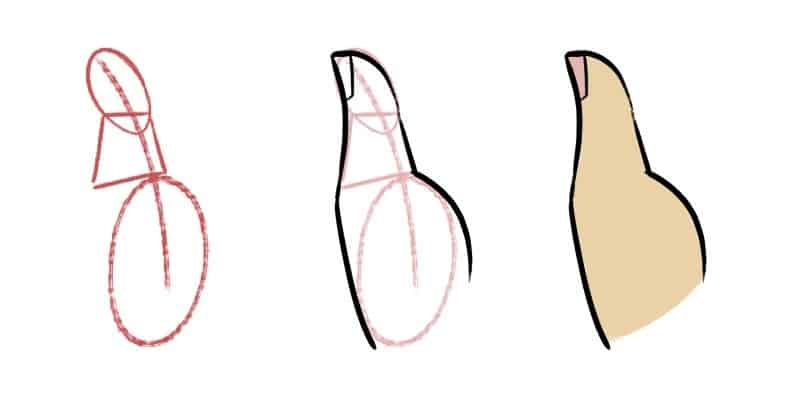
Drawing The Knuckles Of The Hand
Drawing a closed hand is completely different than the open hand!
One of the biggest differences here is that we see a whole lot more of the knuckles, so that will be fun!
They point out of the hand, almost like peaks of mountains or waves in the sea. And depending on how hard the hand is closing, the angrier and sharper they'll look!
Knuckles From The Side
Here, the knuckles won't be as noticeable, but it's a very common position to draw.
Start with a squared shape.
On the bottom of this shape, draw a circle and then a rectangle. This is our thumb.
Since it's flexed, we can't see the whole thumb, so we leave the circle part behind us.
We already drew a flexed finger, so we already know how to do it: draw a square spiral and add the circles if you prefer.
I usually sit them out when drawing a fist, since it will be too cluttered, so the spiral should be enough.
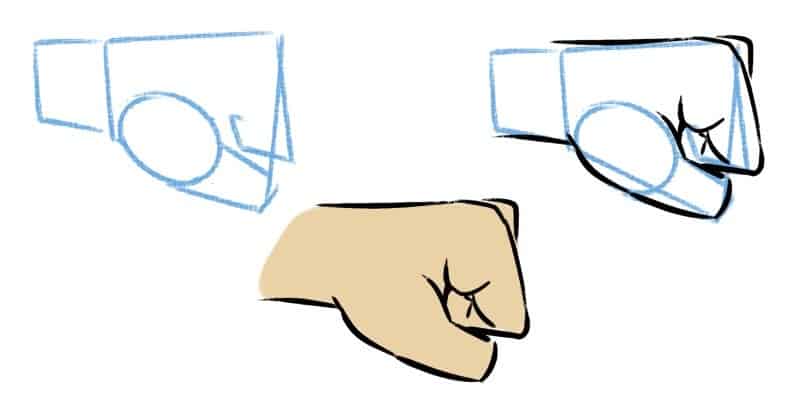
Knuckles From The Front
I feel that this one is the easiest to do!
Start with a rectangle shape, but this one is quite irregular, going up, almost like a chart or a mountain.
Now our thumb will appear in front of the rest of our fingers. So draw a rectangle and circle in front of the main shape.
And behind it, a circle for the rest of the thumb.
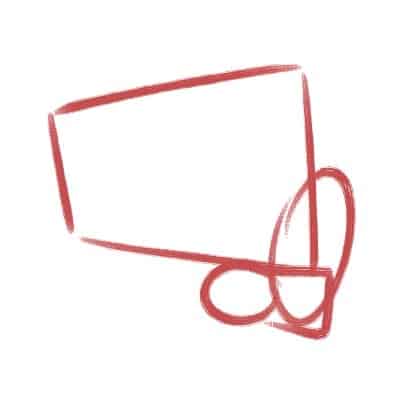
Now, all we need is to add the knuckles and fingers. So, again, let's go with circles!
The middle finger will have its knuckle at its highest point and for the pinky, the lowest.
Now we just need to clean everything up and add the details.
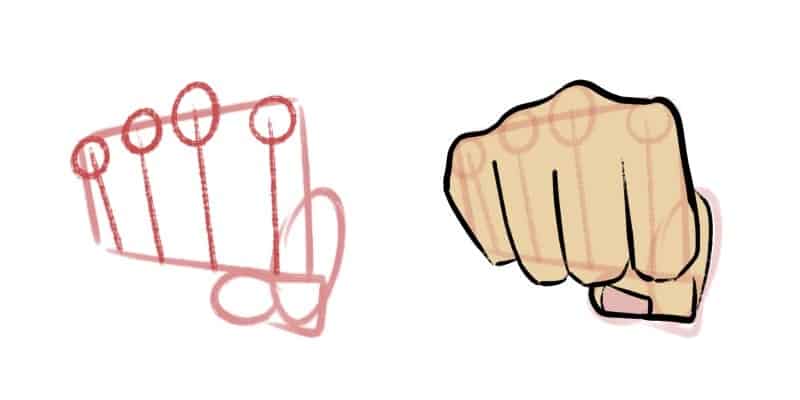
Differences Between Masculine And Feminine Hands
There are many types of hands and each person is different.
But generally speaking, when drawing hands, especially when going for a more cartoony style, we tend to draw hands differently.
Feminine hands tend to have elongated fingers, but more delicate and slim.
When drawing masculine hands, we usually go for broader hands and very thick fingers.
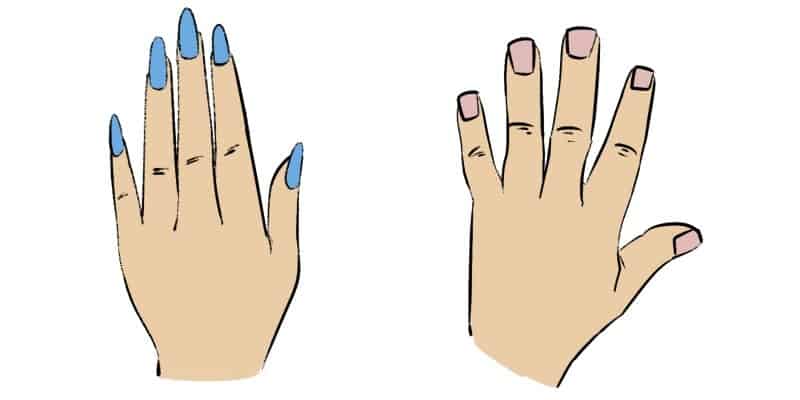
The same goes for the nails.
With feminine hands, we draw more stylized nails and even longer than normal.
If the character we're doing asks for it, we even add nail polish of different colors!
For masculine hands, we usually go for very simple nails, sometimes very squared and big.
Adding Details To The Hands
There are lots of small details that you can add to your character's hands.
If you want to give more expression to your hands, you can do that by adding details.
The poses of the hands will already help you with conveying an emotion, but the details will add so much more to that!
We've already done some nails and an extra line here and there, but let's go over each detail that you can do!
Drawing Hair in the Hands
We always have some hair on our fingers and the back of our hands.
This is usually more noticeable in men.
So if you're drawing a male character that happens to be very hairy, don't forget to add some of it on their hands.
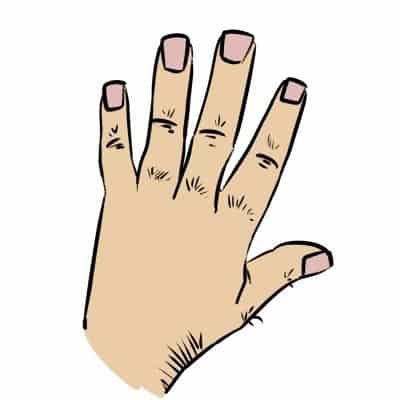
Go simple or exaggerate with all the hand hair!
It's your character and you know them better than anyone.
Experiment a lot and see what works best. And, as always, have fun!
Drawing Hand Wrinkles
This is all about taste.
For me, I usually leave these ones out, but you might prefer to have a more realistic feel or very stylized.
When you look at your hands, the knuckles have some wrinkles.
You can add them to your drawings!
They fit very well if you're drawing either men or older people, where these are more noticeable.

Try different weights on your lines, to give them more or less strength.
Let's say your character is someone who works very hard, especially with their hands.
Then, these wrinkles can be very noticeable, to convey this idea better!
Drawing Fingernails
We already drew some, but again, there's a lot of styles that you try and experiment with.
People have different fingernail types, so explore that in your drawings.
If you're drawing a woman, that is very careful with her looks, then her nails will also look the part!
Elongated nails with pointed ends and even with a different color.
If your character tends to chew on their nails, then, maybe they'll look very short, going below their usual level and even a bit irregular.
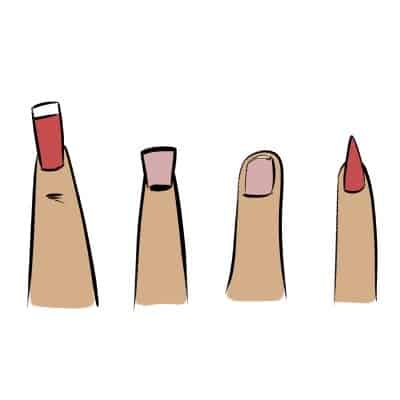
The nails can also be very pointy or round and even squared.
You can them in different sizes and styles and you can even mix and match these styles in one character!
Drawing The Palm Lines
Finally, the palm lines.
When we drew our first hands, we drew them from the back.
If you want to draw a hand facing towards you, the shapes will be exactly the same.
The only difference here is that we'll have some extra lines decorating the hand.
We have dozens of tiny lines all over our palms, but let's focus on the main ones: the thumb line and two horizontal lines above it.
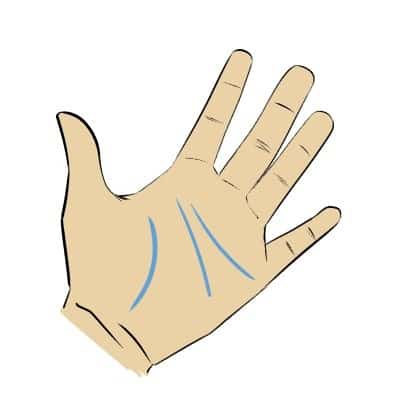
These are the ones you'll want to focus and they'll usually look the same every time.
But you can experiment with different kinds of curves and, again, on how much pressure you apply to these lines.
If you're drawing older characters, for example, these lines might stand out more!
How To Draw Old Hands
Think about your character and their age.
As you draw their hands, they'll look different depending on how aged the character is.
If you're young, you'll notice that your hands are very simple.
Almost no marks and definitely no wrinkles on the backs of the hands.
If you're drawing someone old, then their hands will look different.
Look up on Pinterest or ask to take hand photos of someone older in your family.
Put their hands next to yours and you'll clearly see the differences.
Generally speaking, the skin becomes looser, which means that you'll see more wrinkles on the hands.
Another detail you can add is freckles and different colored spots on the hands.
This is very common to see on older people, so take advantage of that in your drawings!
Another matter that is worth mentioning, is that as you age, your hands tend to become thinner, so pay attention to that as well, when drawing old hands.
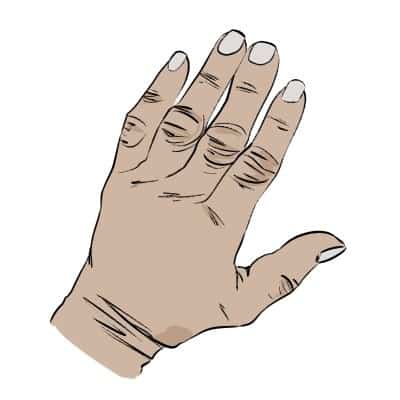
Apart from this, another little detail you can add is some scars.
Both in young and older characters.
We use our hands a lot and it's more than common to get some scars in them.
I sure can count some on my hands, but it might also be because I'm just too clumsy. Oops!
Look for different hand references, take pictures of people you know, of any age.
Compare them and observe the differences. Now, you just need to practice your drawings!
How To Draw Baby Hands
When drawing old hands, we focus on thinner hands and lots of wrinkles, baby hands are almost the opposite!
Here round shapes rule.
Babies tend to be very chubby, so take advantage of this, by exaggerating how round their hands and overall features will be!
Other than that, the hands will usually be smaller, especially the fingers.
Imagine baby carrots on a circle, draw them.
Those are your main shapes, now you just need to clean up everything and add some details.
For this part, there isn't much to do.
Very small fingernails and little dots for the knuckles, like little dimples on the back of the hand!
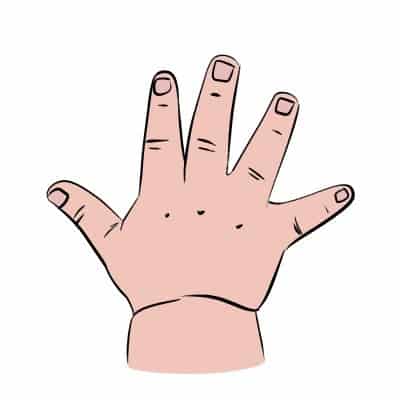
Again, look up pictures on the internet.
Take photos (if you can, babies like to move a lot sometimes, so good luck!) and even study some cartoons.
If you want to go for a cartoony style, this is always a good place to go.
Cartoon movies from Disney, Pixar, Dreamworks, and many others are a good place to get inspiration and to learn.
Watch how they develop their styles over the years and how they create unique characters, not only with their wardrobe or faces but hands as well!
Search, observe, experiment and practice.
These are your only rules for learning how to draw.
And, of course, have fun!
Hand Drawing Tools Online
If you want some exercises to perfect your hand drawings there are some really awesome online tools for that.
I mentioned a lot of times, here and on my Figure Drawing course, some websites where you can practice gesture drawing.
And these are not only good for posing in general and drawing the whole human body but also hands or other particular parts of the body!
Let's see some examples that I particularly like and use a lot.

Line of action
This is a super clean and very helpful website with a cool drawing tool, Line of Action!
With this tool, you simply choose a few settings like male, female and others, and then you can select how much time you'd like to practice each pose and you hit the start button "Get Drawing"!
The tool lets you choose between Hands, Feet or both hands and feet, so if you want to practice feet as well, that's a bonus.
If you're still beginning to learn how to draw hands I would recommend setting it up to 60 seconds or 2 minutes. Later on, you can try the 30 seconds version as well.
In my opinion, it's very good to have a shorter time so that you can focus on the main shapes and not overthink the small details.

Sketchdaily References
Another very similar (and helpful!) drawing tool, Sketchdaily References.
Also has a bunch of different photo references so if you've used the previous website a lot, change to this one for a while so you don't get as many repeats.
To use it simply click the "Body Parts" link up top, select "Hands" in the parts dropdown, the Gender you'd like.
You can also choose the View, the Time (I recommend the 1 to 2 minutes for beginners) and click Start!
Once you get used to the time, try to change it to 30 seconds and see what you can get out of it.
It might be hard and the time might feel like it's too short.
But the more you practice, the more you will improve and create better drawings in a shorter amount of time.

Quickposes
Last one!
Quickposes is another website that you can use to get a bunch of different poses.
It has all the standard options like the ones before and you can choose how many images you'd like to draw in one session.
One interesting feature of this website is that you can choose to display the images upside down.
Which makes for an interesting challenge if you're up for it.
Alright, that should be enough for now, you've got a lot of tools to use! Give them a try and see which one you like the most.
Hand Reference Photos Download
As a bonus, here are a bunch of photos on a white background that I've taken to use as reference!
There are both male and female hands (mine and from my boyfriend) and a lot of different poses from several sides.

Click here for the Hand Reference Photos Download
This includes over 100 photos and 2 videos of hands!
You might even recognize some of these since I've used them in this article and to practice.
You can use these hand photos in your drawings and art as you wish.
Lots of pictures for you to use, so remember to practice a lot!
A Quick Recap On How To Draw Hands
Start with simple shapes and you'll see that your drawings will improve immensely!
Drawing doesn't need to be hard.
We just like to overcomplicate things sometimes.
Before reading this article, you might have felt that drawing hands was a nightmare.
Now, hopefully, you feel that it's much easier and you feel more motivated to draw hands on your characters!
No more hiding your character's hands behind their back, we are better artists now and we're not afraid of hands anymore.
Drawing hands IS fun!
Sit down, get some images for reference and relax while practicing some good hand drawings.
Back to the Blog

How to Draw Hands Step by Step for Kids
Source: https://doncorgi.com/blog/how-to-draw-hands/
0 Response to "How to Draw Hands Step by Step for Kids"
Postar um comentário